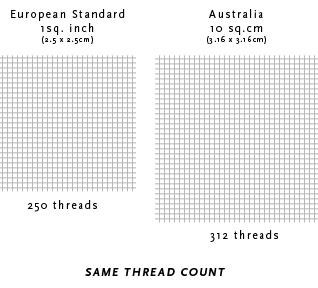Truth about Thread Count

We heard a lot about thread count of fabric, and see a wide range of thread count on the market, some are as high as over 1000 thread counts. If you learn nothing else from this website learn this:
HIGHER THREAD COUNT ≠ BETTER QUALITY.
The ideal thread count for your sheets depends entirely on the type of sheets you are going to buy. This is because the meaning of thread count is simply the amount of threads that fill a certain area of your sheet. Therefore the finer the material your sheet is made out of the higher thread count can be.

The European standard is the amount of threads that occupy one square inch, while in Australia it is more common to use 10 square centimeters. The lack of an international standard means that even sheets with the exact same thread density can be labelled as having different thread counts.
More Information on the True Meaning of Thread Count
As you can see from the above image there can really only be a certain number of threads that can fit into the defined area. So the idea that thread counts can go up to some of the huge numbers you see on some packaging just doesn’t make sense.
It is also true that fitting the maximum amount of threads into the square inch of a sheet is not necessarily ideal. Just because a certain amount of threads can fit in a defined area, this doesn’t necessarily mean it is a good thing. For example, linen is a very high quality fabric, but can have a thread count as low as 50. Its thread count is only low because of the way that the fabric is woven to provide its looser weave and finish.
Why do so many sheets have thread counts with such high numbers?
Over many years of marketing thread count has been highly associated with being a mark of quality.
Many sheet companies have hijacked this loose understanding about thread count by trying to promote the idea that the higher the number the better bed sheets are (and more expensive).
And as the average consumer has no easy way to measure thread count they are at the mercy of the retailers honesty when declaring their products thread count, for example, make multiply fabric to amplify the thread count numbers.
So, How Can I Determine the True Thread Count of My Sheets?
As you have no way of measuring the thread counts of your sheets yourself, the above information can seem a little disheartening.
However if you read through this website and do your research you will be more than equipped to find the brands out there that are honest and upfront about their sheets.
Generally, the higher the thread count, the softer the sheet, and the more likely it will wear well — or even soften — over time. Good sheets range anywhere from 200 to 800, although you'll occasionally see numbers over 1,000. Astronomical thread counts don't necessarily mean the sheet is better — there are even tricks to inflating the thread count (such as using multiple yarns twisted together) that don't actually improve the hand of the fabric and may even detract from its quality.
Don't assume a low thread count means low-quality sheets. There are 200-count cotton sheets out there that are finished very nicely and actually feel like they have a higher thread count, fewer chemicals and more mechanical finishings are used these days, giving a nice hand and performance.
For a pure cotton ideal sheet is a combed cotton sheet in the 300 to 500 thread count range. KOZIS sheets are only made with the optimal thread count fabric to provide the ideal quality, softness and comfort. Our classic sheets are 300 thread counts and Luxe sheets are 500 thread counts. Find out the KOZIS difference.
Leave a comment
Comments will be approved before showing up.
Also in QX Brands Journal

MJS Cotton-Rich with SILVADUR technology

One Chart Shows The Best And Worst Face Mask Types, Based on The Latest Research
- The ideal face mask for coronavirus protection blocks large droplets along with smaller airborne particles.
- In general, masks should have more than one layer and be made of tightly woven fabrics.
- Based on several studies evaluating masks' protection levels, we've ranked the most common types from best (an N95 mask) to worst (masks with a built-in valve or vent).



